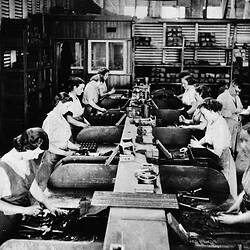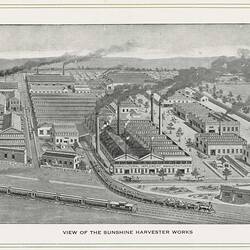Summary
First hand accounts of women who worked at Sunshine Harvester Works
Jesse Smith
Jesse began working in the Sunshine Harvester Works Bolt Shop in 1930 and remained with the company until 1960. She recalls the difficult conditions in the Shop but still enjoyed her time there:
You'd get dirt up to your elbows sometimes. You put soap around your nails to keep the dirt from going under your nails and then your nails were worn right down. And then you tied paper around your feet like spats because the water from the machine used to splash on you. And we had to wear black or navy blue overalls and hairnets . All the same we enjoyed every minute of it. I loved my time in the Bolt Shop.
Betty Oke
In the 1940s, Betty worked in the Binder Shop which resulted in an injury:
I was drilling holes in bits of iron, something to do with agricultural implements, I suppose. I've got the scar now! The drill got stuck in the hole and there were no guards. The thing whizzed around and cut my finger right to the bone.
The environment was also busy in the Canvas Shop:
The foreman's name in the Canvas Shop was Naylor. His 'pets' would get put on to do the canvas. I was a 'pet' until I became militant about piece-work. I was making these canvas binders that go on the back of some of the harvesters and the wheat thrashes over them. I was put on this huge industrial dewing machine, and we had great big rolls of canvas on the end of this long bench. We pulled the canvas along, and straighten her all out, cut the size and then sew up the ends. That was what we'd call a good job. And if you worked hard it was profitable. Some of them were getting about five pounds a week, which was good money.
Betty also worked in the Bolt Shop in the early 1940s and recalls the difficult conditions:
Oh, God! It was frightful! It was huge and dark-looking, almost like Dickens' time. The job I was on was nuts. The nuts had great big sharp bits of iron sticking out when they'd been made. I had to pick up these nuts and put them in a nut space in this machine, and the sharp fringe would get cut off. And your hands! You had no nails, and your fingers were all cut and black - it was revolting.
Anne Laverick and Connie Robinson
Women mostly worked in the Core Shop. They stood at their work benches all day, creating cores. Anne Laverick and Connie Robinson remember working in the area during World War II:
In the foundry when the cores 'blow' (explode when hot metal is poured into the casting), they are called 'shitters'. That's a foundry term . It's like making sandcastles . It's like making biscuits; like cakes, they all come out on trays to be cooked . We used to get paid per hour, per 100. For 100 cores, I might get two hours' pay . During the War we switched to war-production, such as cores for track links for Bren gun carriers and cores for 6½ pound bombs. Just about the whole factory was on war-production, 24 hours. Not all of us were on war-work, the inexperienced ones were still doing (agricultural) implements.
More Information
-
Keywords
Women's Work, Factory Workers, Occupational Health & Safety, World War II, 1939-1945
-
Authors
-
Article types




